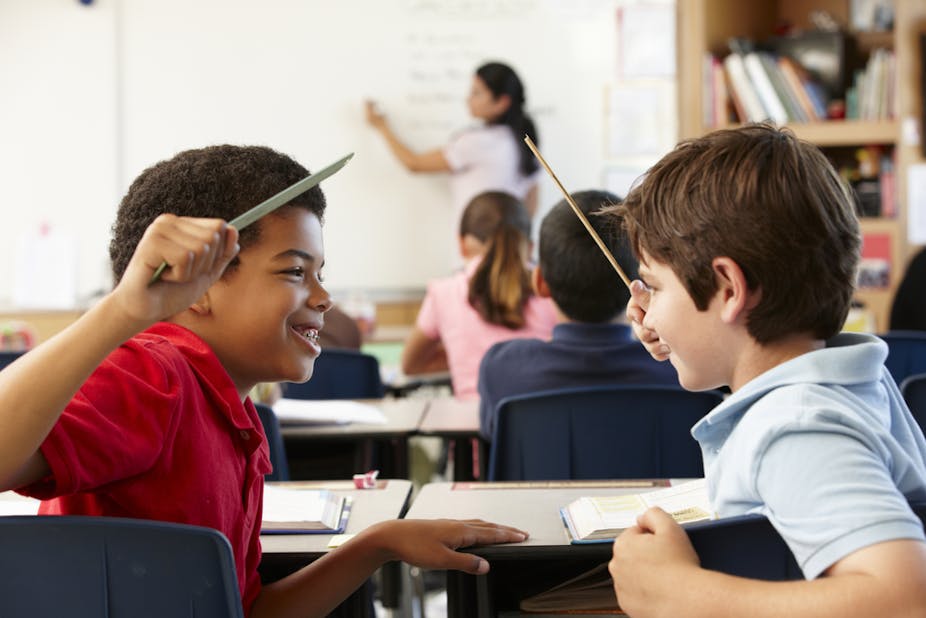A few mischievous children acting out in a classroom and disrupting an entire lesson is a common scenario that teachers deal with. However, trouble-making children who hit out and misbehave are not only disruptive to teachers and classrooms, they are also likely to get lower grades.
In recent research, my colleagues and I examined the links between the development of problem behaviour in 5,400 children between the ages of eight and 11 from 138 primary schools in England. The children were in Years 4, 5 and 6 – the last three years of primary school and what’s called Key Stage 2. We found that those who developed disruptive behaviour in these three “middle childhood” years did worse in the tests, also known as SATs, at the end of Year 6.
The problem behaviours we looked at in our study were when children got angry, hit out, broke things, hurt people or lost their temper. These behaviours were measured through a questionnaire in the Me and My School study, a study of mental health in English schools, funded by the Department for Education.
Children whose problem behaviours improved between Years 4 and 6 still did relatively badly in the maths, literacy and science tests at the end of primary school compared to their peers who had never demonstrated any problem behaviours. The gains these better-behaving children made between tests at Key Stage 1 (age seven) and Key Stage 2 tests (age 11) were slightly less than those children who had been well-behaved throughout. As the graph below shows, 67% of these children met the governments Key Stage 2 targets. In comparison, 77% of children who had no problem behaviours at all throughout these later years of primary school, attained the expected standard.
This suggests that the learning lag caused by problem behaviours at a younger age might lead to reduced academic performance, even when the problem behaviours have subsided. The negative effects of bad behaviour on learning can be hard to make up fully. However, the ones who improve their behaviour do still do significantly better than their misbehaving peers.
Children whose behaviour worsened during the later years of primary school showed the least progress between the Key Stages. Just over 50% of the children with increasing behavioural problems over these three years of primary school met the government’s Key Stage 2 targets.
There is plenty of evidence showing that both behaviour and attainment in childhood have life-long consequences: for economic, social and health outcomes as well as life satisfaction.
About half the children in the age group we studied demonstrated no conduct problems at any age. Another third demonstrated moderate levels of disruptive behaviour by the final year in primary school. In those children we studied, 3% went from being well-behaved to demonstrating high levels of problem behaviour. Another 10% already demonstrated problem behaviours by Year 4 which continued up to Year 6, while 5% had reduced their problem behaviours in these years.
So in an average classroom of 25 to 30 children, we estimate that four of them would display high levels of problematic conduct or disruptive behaviour. This affects the teaching environment of classrooms and makes it tougher for teachers to teach and other students to learn.
Can early intervention help?
Our results suggest there may be a relationship between disruptive behaviour and the capacity of a child to benefit from school, and therefore on their grades. But it’s also possible that a whole host of other factors negatively affect a child’s learning and behaviour. Children developing problem behaviours in the age group we studied were more likely to be boys, have special educational needs, be eligible for free school meals and have had lower scores earlier on in primary school.
It is possible that both explanations are at play, with a certain amount of negative consequences begetting more negative consequences in a vicious cycle.
Whatever the cause, early intervention to improve behaviour could be key. Research in England indicated that when schools were provided funding to support their students’ mental health, primary schools mainly used the money for interventions targeted towards student’s disruptive behaviours. The additional funding and support was associated with a decrease in problem behaviour.
The recent appointment of former teacher and blogger Tom Bennett as a school “behaviour Tsar” shows that the government is taking behaviour seriously. But schools would still benefit from greater resources to be able to support their students to minimise the impact of adversity and problem behaviour on learning and healthy development.

